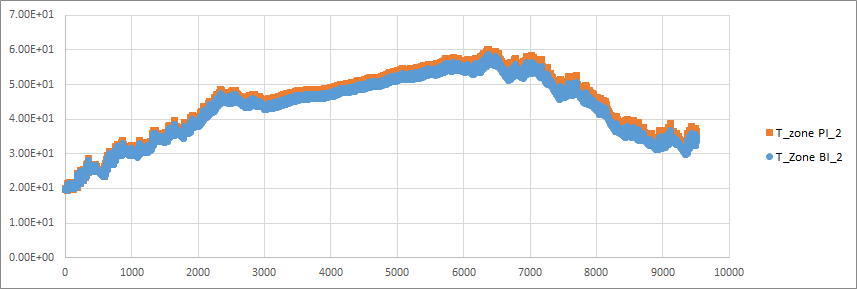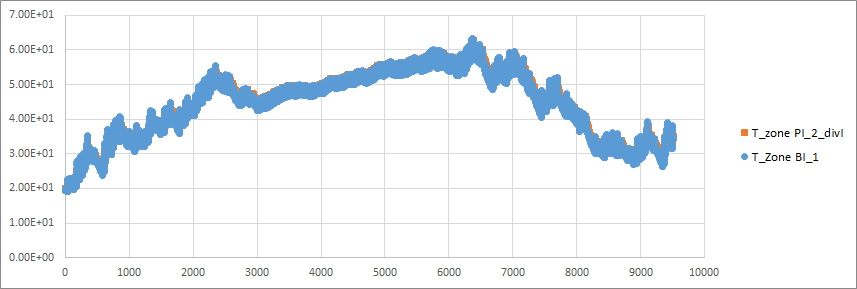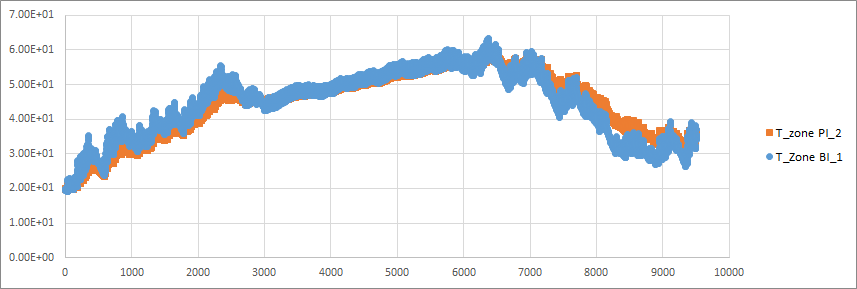Dear
Loïc,
Mhm, maybe the heat fluxes on your surfaces aren’t the same due to different definitions (wall definition, solar absorption, heat transfer coefficients, surface gains,
different temperature of other surfaces or air, …).
If you are really sure you have set everything equal for both surfaces and zones you may send your examples to
hotline@transsolar.com
including your Trnsys Version number, Trnsys licenses number, company name and address.
Regards,
Marion
-----------------------------------------------------------------------------------------------------------------------------------------------------------
Dipl.-Ing. Marion Hiller
TRANSSOLAR Energietechnik GmbH
Stuttgart - Munich - New York - Paris
t:
+49.711.67976.0 f:
+49.711.67976.11
www.transsolar.com/
KlimaEngineering - Technologien für energieeffizientes Bauen und Nutzerkomfort in Gebäuden
Transsolar Energietechnik GmbH, Curiestrasse 2, 70563 Stuttgart
Amtsgericht Stuttgart - HRB 23347
/ Steuernummer: 99073/00911 / USt-IdNr.: DE 152272639
Geschäftsführer: Matthias Schuler, Thomas Auer, Stefan Holst, Dieter Schnelle
Von: TRNSYS-users <trnsys-users-bounces@lists.onebuilding.org>
Im Auftrag von Loïc Frayssinet via TRNSYS-users
Gesendet: Dienstag, 26. Februar 2019 14:10
An: trnsys-users@lists.onebuilding.org
Cc: Loïc Frayssinet <frayssinet@enertech.fr>
Betreff: Re: [TRNSYS-users] Internal wall modelling
Dear Marion,
Thank for your response.
I'm surprised that equivalents results with (a) and (b) are get with 2*S area, as it is not what I observe (with an hypothetical zone only having one window and one internal wall):
(plots = temperature of the zone over the time)
- (a), area = 2*S ['T_zone_PI_2'] and (b), area = 2*S ['T_Zone BI_2'] with the same symetric composition :

Results are actually very similar, but error seems to regularly increase over the time.
- (a), area = 2*S, half composition ['T_zone_PI_2_divI'] and (b), area = S, whole composition ['T_Zone BI_1'] :

Results are nearly identical.
- (a), area = 2*S ['T_zone_PI_2'] and (b), area = S ['T_Zone BI_1'] with the same composition:

(a) thermal mass is clearly higher than (b)
By the way, I'm not sure to understand why (b) requires 2*S. For a 'classic' wall having a area S, the thermal flux of the inside face (phi_i) goes to the inner zone (P_i=phi_i*S) and the thermal flux of the outside face (phi_o) goes to the outer zone (P_o=phi_o*S).
When we defined this wall 'boundary/indentical', as the inner and outer zone is the same, it automatically receives P_i + P_o via both (inside and outside) faces (2*S), whitout having to set a 2*S area. Unless the implementation is different with these options,
as you seem to indicate (parametrizing the global exposed area (2*S)). In this case, is it sure that the surface is not accounted for 2 times (due to inside and outside exposure and using 2*S area)?
Regards,
Le 26/02/2019 à 11:43, Marion Hiller via TRNSYS-users a écrit :
Dear Loïc
I have to confess that this is a little confusing.
I would have loved to remove the surface category “internal” completely. However, due to backwards compatibility it remained.
I recommend to use category 'boundary' and the boundary condition 'identical' because there it is more clear what is calculated.
Please find my comments below:
I noticed that the first option implies to consider the total exposed surface (both sides) for the area parameter, unlike the second one. I guess that in (a) the middle of the wall is assumed adiabatic in order to model only a half wall but with an area 2 times higher. If this is correct, it is implicitly assumed that the internal wall composition is symetric. By the way, I found that the wall balance is not null otherwise.
Is the (a) modelling really only concern symetric composition?
=> Yes, for the option “internal” the composition has to be internalNonetheless, when I compare (a) with a 2*S area and (b) with a S area, for a symetric composition, the results are not exactly the same. I succeed having same results by setting the composition of (a) with only the half of it (from a face to the middle).
=> For having (a) and (b) giving similar results you have to use for (b) the same exposed area to the airnode/zone as for (a) (area =2*S).
Otherwise the airnode/zone doesn’t have “access” the same amount of thermal mass. This results in different heat fluxes to the inner surface
node.So, the (a) modelling need half composition?
=> No, (b) requires double area (see above).
Have in mind that “Internal” means that both sides of the construction are facing towards the zone. You have to define the total construction
for having the correct mass. The program divides the construction itself.
Regards,
Marion
-----------------------------------------------------------------------------------------------------------------------------------------------------------
Dipl.-Ing. Marion Hiller
TRANSSOLAR Energietechnik GmbH
Stuttgart - Munich - New York - Parist: +49.711.67976.0 f: +49.711.67976.11
www.transsolar.com/
KlimaEngineering - Technologien für energieeffizientes Bauen und Nutzerkomfort in Gebäuden
Transsolar Energietechnik GmbH, Curiestrasse 2, 70563 StuttgartAmtsgericht Stuttgart - HRB 23347 / Steuernummer: 99073/00911 / USt-IdNr.: DE 152272639
Geschäftsführer: Matthias Schuler, Thomas Auer, Stefan Holst, Dieter Schnelle
Von: TRNSYS-users <trnsys-users-bounces@lists.onebuilding.org> Im Auftrag von Loïc Frayssinet via TRNSYS-users
Gesendet: Donnerstag, 21. Februar 2019 15:35
An: trnsys-users@lists.onebuilding.org
Cc: Loïc Frayssinet <frayssinet@enertech.fr>
Betreff: [TRNSYS-users] Internal wall modelling
Dear all,
I was wondering if it is similar to model an internal wall as a wall :
(a) with the category 'internal' or
(b) with the category 'boundary' and the boundary condition 'identical'I noticed that the first option implies to consider the total exposed surface (both sides) for the area parameter, unlike the second one. I guess that in (a) the middle of the wall is assumed adiabatic in order to model only a half wall but with an area 2 times higher. If this is correct, it is implicitly assumed that the internal wall composition is symetric. By the way, I found that the wall balance is not null otherwise.
Is the (a) modelling really only concern symetric composition?
Nonetheless, when I compare (a) with a 2*S area and (b) with a S area, for a symetric composition, the results are not exactly the same. I succeed having same results by setting the composition of (a) with only the half of it (from a face to the middle).
So, the (a) modelling need half composition? If yes, why non-symetric compositions causes balance divergences?
Regards,
--
Loïc FRAYSSINET
_______________________________________________TRNSYS-users mailing listTRNSYS-users@lists.onebuilding.orghttp://lists.onebuilding.org/listinfo.cgi/trnsys-users-onebuilding.org
--
Loïc FRAYSSINET